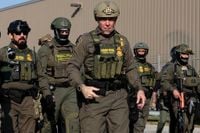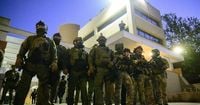Federal agents are descending on the San Francisco Bay Area this week, setting off a political firestorm and reigniting a fierce national debate over immigration enforcement, state sovereignty, and the role of the military in American cities. The deployment, which begins Thursday, October 23, 2025, will see more than 100 U.S. Customs and Border Protection (CBP) and other federal agents operating out of the U.S. Coast Guard base in Alameda, strategically positioned between the sanctuary cities of Oakland and San Francisco. According to The San Francisco Chronicle and statements confirmed by the Department of Homeland Security (DHS), this move is part of a broader federal effort to track down immigrants in the country illegally and bolster border and maritime security.
The announcement drew immediate and vehement opposition from California’s top officials. San Francisco Mayor Daniel Lurie and Governor Gavin Newsom both condemned the deployment as a deliberate provocation intended to incite “chaos and violence.” In a nine-minute livestream from City Hall, Lurie, flanked by other city leaders, warned, “These tactics are designed to incite backlash, chaos and violence, which are then used as an excuse to deploy military personnel.” He urged residents to protest peacefully and signed an executive directive to coordinate the city’s response and provide support for immigrants. Oakland Mayor Barbara Lee echoed these sentiments, declaring, “Real public safety comes from Oakland-based solutions, not federal military occupation.”
Governor Newsom, a former San Francisco mayor himself, did not mince words. He called the deployment “a page right out of the dictator’s handbook” and accused President Donald Trump of deliberately sowing unrest. “He sends out masked men, he sends out Border Patrol, he sends out ICE, he creates anxiety and fear in the community so that he can lay claim to solving that by sending in the [National] Guard,” Newsom said, according to The Los Angeles Times. “This is no different than the arsonist putting out the fire.”
The Trump administration, for its part, has made no secret of its intentions. Over the weekend prior to the deployment, President Trump told Fox News, “We’re going to San Francisco and we’ll make it great. It’ll be great again.” The administration has repeatedly cited what it claims are out-of-control crime rates and lawlessness in cities led by Democratic officials, naming San Francisco, Chicago, Los Angeles, and Portland as particular targets for federal intervention. In a statement provided to the media, the Coast Guard emphasized a “whole of government approach,” aiming to “detect, deter, and interdict illegal aliens, narco-terrorists, and individuals intent on terrorism or other hostile activity before they reach our border.”
Homeland Security spokesperson Tricia McLaughlin reinforced the message on NewsNation’s “The Hill,” stating, “We do have ICE officers on the ground in San Francisco. That’s not a change in posture.” She added that a “stepped-up presence” could be expected “in any of these sanctuary cities.” McLaughlin was blunt about the administration’s priorities: “There would be no safe haven in the United States, whether that be Los Angeles, Chicago, New York or San Francisco.”
The federal government insists its focus is on the “worst of the worst” criminal illegal aliens, with a DHS spokesperson specifying targets such as “murderers, rapists, gang members, pedophiles, and terrorists.” Yet, city and state leaders argue that the deployment is less about public safety and more about political theater. San Francisco City Attorney David Chiu and California Attorney General Rob Bonta have promised to challenge any military deployment in court. Newsom, holding up a prepared lawsuit at a press conference, vowed, “We’re going to be fierce, we’re going to be focused in terms of our response. Quite literally, this is the lawsuit that I will file within a nanosecond of any effort to send the military to one of America’s great cities, San Francisco.”
Underlying the political clash is a stark disagreement over the facts on the ground. President Trump has decried San Francisco as a city in crisis, but local leaders point to data showing significant improvements in public safety. Mayor Lurie recently stated that “violent crime in San Francisco has fallen to levels not seen since the 1950s. Encampments are at record lows. San Francisco is turning the corner—thanks to public safety.” Governor Newsom added that the city is experiencing its lowest homicide rate in 60 years and described it as “one of the safest large cities in this country that’s experiencing an economic rebirth and growth.”
This isn’t the first time the Trump administration has sent federal agents or troops into American cities. National Guard units have previously been deployed to Los Angeles, Chicago, Memphis, and Washington, D.C., with mixed results and varying levels of cooperation from state and local governments. The White House, through spokesperson Abigail Jackson, has pointed to drops in crime following these deployments, particularly in Washington, D.C., and Memphis, and urged San Francisco officials to “look at the tremendous results in DC and Memphis and listen to fellow Democrat Mayor Bowser and welcome the President in to clean up their city.”
But legal and practical limitations complicate the prospect of a military presence. The National Guard, when federalized, generally does not have the authority to make arrests or investigate crimes without the consent of the state governor. San Francisco District Attorney Brooke Jenkins clarified this point, explaining, “I want to make sure that San Franciscans understand that the National Guard would not have any legal authority to make arrests or investigate crime.” She further noted that the Guard is not equipped “to curb the fentanyl crisis or retail theft or the issues that are most pressing here.” Mayor Lurie concurred, stating that while the city still faces challenges with fentanyl use, “the National Guard cannot arrest drug dealers or shut down open-air drug markets.”
The Coast Guard base in Alameda, now the operational hub for the incoming federal agents, sits at the intersection of two cities with longstanding sanctuary policies, both of which have consistently refused to cooperate with federal civil immigration operations. The symbolism is not lost on either side of the dispute. For federal authorities, it represents a strategic foothold in a region they see as resistant to immigration enforcement. For local leaders, it’s a flashpoint in the ongoing struggle over local autonomy, immigrant rights, and the boundaries of federal power.
As the agents arrive and the city braces for potential protests, the eyes of the nation are once again on San Francisco—a city that has, for better or worse, become a battleground for some of America’s most contentious debates. Whether this latest chapter will bring about meaningful change, lasting division, or simply more legal wrangling remains to be seen. For now, both sides appear ready to dig in, each convinced that the future of the city—and perhaps the country—hangs in the balance.





